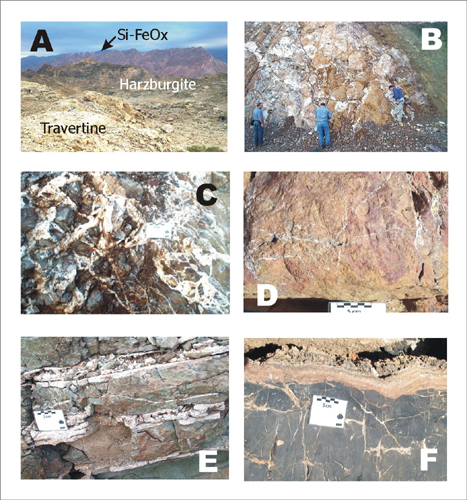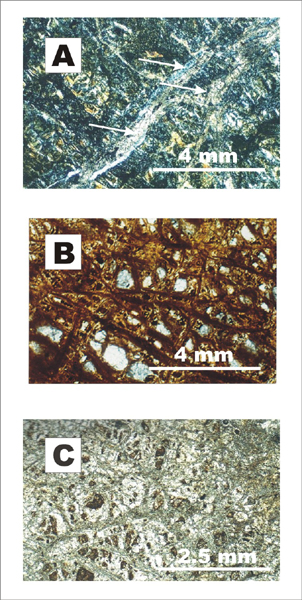Preliminary
study of Cenozoic hydrothermal alteration and platinum deposition in the
Oman Ophiolite
Geological Framework (continued)
Tertiary Extension & Inversion
Tertiary extension in northern Oman commenced just after obduction of the ophiolite and persisted until at least until deposition of the Eocene Rusayl formation (Fournier et al., 2001). The main axis of extension was NNE-SSW to NE-SW and produced numerous NW trending structures (e.g. Fig. 1; Fournier et al., 2001). Neogene compression resulted in inversion of these structures (Fournier et al., 2001).
Evidence for elevated heat flow during the early Tertiary includes the presence of minor mafic dykes that were intruded into Tertiary sediments near the cement factory at between 36 and 40 million years (Fig. 1; Al Harthy et al., 1990). This magmatic episode has also been recognised in the Batain region of NE Oman, some 250 km distant from the area of interest (Worthing and Wilde, 2002) and appears, therefore, to be of considerable extent. Spore coloration and AOM reflectance measurements on shales and coaly shales from the Rusayl Formation (outcropping about 20 km from the study area) show that maximum temperatures at the base of the Tertiary were of the order of 65¼C (Goodall et al., 2001a,b). Vitrinite reflectance data from the Abat Trough about 200 km SE of the study area also indicate unusually elevated temperatures during the Tertiary (Abdulrahman Al Harthy, unpub. data) and support the idea that this event was of regional rather than local extent.
The area of interest was partially emergent during the Tertiary (generating laterites) with adjacent mangrove tidal swamps and other warm-water shallow marine environments (El Beialy, 1998; Racey, 1994). During the Eocene, there is some evidence for hypersaline conditions in coastal lagoons (Keen & Racey, 1991). These observations are of some significance to the discussion of potential ore-forming fluids (see below).
Field & Mineralogical Observations
We recognise two main facies of hydrothermal alteration: Ca-Fe-Mg carbonate (CFM) and silica-iron hydroxide (SIH), both developed extensively (although not exclusively) in serpentinised ultramafic rocks. Figure 1 shows SIH hydrothermal alteration as mapped by Villey et al. (1986) and described as “listwaenite”. The major occurrences are clustered within an area approximately 15 by 10 km (Fig. 1) and tend to be controlled by NW-SE (post-obduction) faults and/or the base of the ophiolite sequence. The latter has been interpreted to reflect the presence of thrust fault permeability (Stanger, 1985). Some of the largest occurrences of altered rocks are along the Paleogene Fanjah fault (Hanna & Rodgers, 1996 & 2001). This is a normal fault that dips to the north with at least 6 km of normal slip and transects early thrust faults (Hanna & Rodgers, 1996 & 2001).
The distinctive SIH alteration forms linear peaks, as the rock is more resistant to erosion than adjacent carbonated serpentinite and Tertiary sediments (Fig. 2a). These peaks are incised by recent wadis and overlain by Quaternary wadi sediments. Pervasive silicification and iron metasomatism has also been noted in Tertiary limestone excavations at the cement factory (Fig. 1; Haynes, 2001). These observations strongly support a Tertiary age for the alteration event.
| Figure 2: Photographs showing various manifestations of hydrothermal alteration. A: Ridge of silica-iron hydroxide (SIH) alteration in background with low rounded mound of pale-coloured travertine in foreground. B: One of the best exposed examples of hydrothermal alteration – Fanja roadcut. The photograph shows reticulate (stockwork) quartz veining in tan-coloured silicified host-rock. C: Close up of the above showing breccia texture, possibly indicative of high fluid pressures and hydraulic fracturing. D: Fine quartz veinlets at the “pipeline” occurrence. E: Travertine veins in serpentinised harzburgite. F: Travertine veins and coating on dolomite. |
Individual SIH bodies are vertical or sub-vertical, typically about 10m thick, but locally up to 50m thick and associated with a reticulate stockwork of milky white quartz veins (Fig. 2b-d). Vein thickness varies from a few millimetres to several centimeters. Pervasive silicification extends outwards from the veins (interpreted as the result of fluid moving outwards from the vein conduit) and grades gradually into the carbonate-dominant alteration facies. Pervasive silicification overprints the carbonated ultramafic rocks. It is not clear, however, whether this overprinting is due to an age difference between the two alteration types or due to variation in fluid chemistry with distance from the main conduit or conduits. Rare pseudomorphs after pyrite were noted at several locations (comprising less than 1% by volume of the rock) and rosettes of gypsum were observed on some fracture surfaces. The latter are probably related to evaporation of contemporary groundwaters.
Quartz veins in SIH show a variety of textures. In some cases, where there is a high density of veins the rock is a tectonic breccia (Fig. 2b). Angular fragments can be fitted back together suggestive of high fluid pressures. Veins commonly exhibit crustiform layering, with individual bands defined by coxcomb-textured quartz. There are often central cavities in which nodular aggregates of quartz (and in some instances chalcedony) complete the paragenetic sequence. The veins show no textural evidence of boiling. For example, lattice-textured quartz after carbonate has not been observed, nor development of adularia that is typical of epithermal precious metal deposits formed as a result of boiling. Massive hematite is spatially associated with SIH at the Fanja roadcut occurrence (Fig. 1) where it occupies a steeply dipping fault.
Petrographic study reveals textures that are very similar to those of the CFM rocks (Fig. 3b). The serpentinite minerals have been almost completely replaced by crypto-crystalline quartz (confirmed by XRD measurements) and hematite and/or goethite. Nevertheless the original serpentinite mesh textures are clearly visible (Fig. 3b). The CFM alteration facies is defined by pervasive replacement of serpentinite by very fine-grained carbonate (Fig. 3a). It is best developed between SIH and serpentinite in the area of interest, but we cannot be sure that such alteration is restricted to the periphery of SIH zones. CFM alteration ranges from low volumes of carbonate veinlets that mimic antigorite veinlets to massive replacement. X-ray diffraction study has demonstrated the presence of ankerite, dolomite and calcite. Phases presumably inherited from the serpentinite include lizardite, antigorite and chrysotile, together with chromite and magnetite, a probable relict of the serpentinisation process.
| Figure 3: Photomicrographs. A: Partially carbonated serpentinite. Sample FQ4550. Crossed polars. Calcite veinlets (arrowed) exploit pre-existing serpentinite veinlets. B: SIH “Listwaenite”. Sample FQ4549. Plane-polarised light. C: Travertine. Sample FQ4593. Plane-polarised light. Note evidence of serpentinite replacement. |
Several samples of travertine were studied because these also represent carbonate-altered serpentinite (Fig. 3c) although there are equally obvious examples where carbonate has precipitated as a surface or joint-related coating (Fig. 2e, f). The replacive textures are remarkably similar to those of CFM-altered serpentinite adjacent to SIH.

